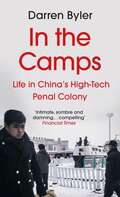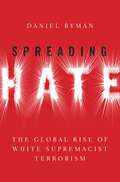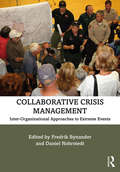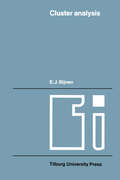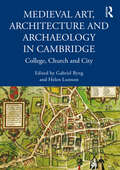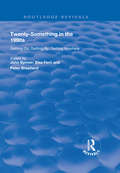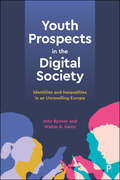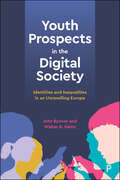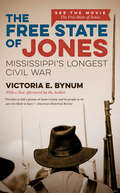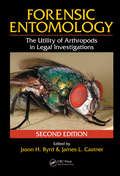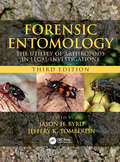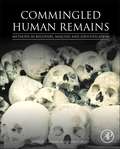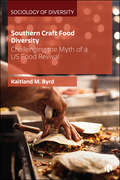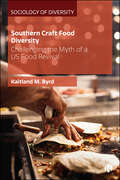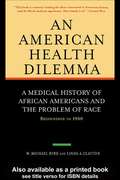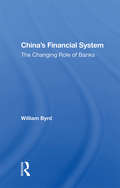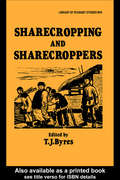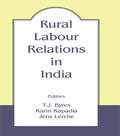- Table View
- List View
In the Camps: Life in China’s High-Tech Penal Colony
by Darren Byler'Intimate, sombre, and damning... compelling.' Financial Times'Chilling... Horrifying.' SpectatorIn China's vast northwestern region, more than a million and a half Muslims have vanished into internment camps and associated factories. Based on hours of interviews with camp survivors and workers, thousands of government documents, and over a decade of research, Darren Byler, one of the leading experts on Uyghur society uncovers their plight.Revealing a sprawling network of surveillance technology supplied by firms in both China and the West, Byler shows how the country has created an unprecedented system of Orwellian control. A definitive account of one of the world's gravest human rights violations, In the Camps is also a potent warning against the misuse of technology and big data.
Spreading Hate: The Global Rise of White Power Terrorism
by Daniel BymanSpreading Hate examines the evolution of the white power movement around the world, explaining its appeal and the threat it poses as well as many failures. The modern white power movement is now a global, transnational phenomenon. In this sweeping, authoritative account, Daniel Byman traces the key moments in the white power movement's evolution in the United States and around the world and then details its many facets today. Using a wide range of sources, Byman explodes several myths about white power terrorism and exposes dangerous gaps in current policies. For almost two decades since 9/11, white supremacist terrorism has been relegated to a secondary concern in the US and Europe despite the fact that it was clearly metastasizing. This neglect has led to shocking episodes of violence from New Zealand to Norway to South Carolina and has eroded faith in Western democratic institutions. Because white power terrorists' grievances echo mainstream debates and their violence often exacerbates polarization, their political impact can be inordinately high even if the body count is low. As Byman stresses, they are not a hide-bound movement seeking to turn back the clock, but are dynamic, drawing on ideas from around the world and exploiting the most cutting-edge technologies, especially social media. White power terrorists, however, have many weaknesses. They are divided, with poor leadership, and often attract the incompetent and the criminal as well as the dangerous and deluded. If governments act decisively and treat white power terrorism with the same urgency they use to manage jihadist violence, then the threat can be reduced. This will require aggressive law enforcement, international intelligence cooperation, crackdowns by technology companies, and other forceful steps. Considering policy solutions as well as synthesizing a vast body of scholarly research, Spreading Hate will be essential reading for anyone worried about this an increasingly networked movement that threatens to grow more dangerous in the years to come.
Spreading Hate: The Global Rise of White Power Terrorism
by Daniel BymanSpreading Hate examines the evolution of the white power movement around the world, explaining its appeal and the threat it poses as well as many failures. The modern white power movement is now a global, transnational phenomenon. In this sweeping, authoritative account, Daniel Byman traces the key moments in the white power movement's evolution in the United States and around the world and then details its many facets today. Using a wide range of sources, Byman explodes several myths about white power terrorism and exposes dangerous gaps in current policies. For almost two decades since 9/11, white supremacist terrorism has been relegated to a secondary concern in the US and Europe despite the fact that it was clearly metastasizing. This neglect has led to shocking episodes of violence from New Zealand to Norway to South Carolina and has eroded faith in Western democratic institutions. Because white power terrorists' grievances echo mainstream debates and their violence often exacerbates polarization, their political impact can be inordinately high even if the body count is low. As Byman stresses, they are not a hide-bound movement seeking to turn back the clock, but are dynamic, drawing on ideas from around the world and exploiting the most cutting-edge technologies, especially social media. White power terrorists, however, have many weaknesses. They are divided, with poor leadership, and often attract the incompetent and the criminal as well as the dangerous and deluded. If governments act decisively and treat white power terrorism with the same urgency they use to manage jihadist violence, then the threat can be reduced. This will require aggressive law enforcement, international intelligence cooperation, crackdowns by technology companies, and other forceful steps. Considering policy solutions as well as synthesizing a vast body of scholarly research, Spreading Hate will be essential reading for anyone worried about this an increasingly networked movement that threatens to grow more dangerous in the years to come.
Collaborative Crisis Management: Interorganizational Approaches to Extreme Events
by Fredrik Bynander Daniel NohrstedtPublic organizations are increasingly expected to cope with crisis under the same resource constraints and mandates that make up their normal routines, reinforced only through collaboration. Collaborative Crisis Management introduces readers to how collaboration shapes societies’ capacity to plan for, respond to, and recover from extreme and unscheduled events. Placing emphasis on five conceptual dimensions, this book teaches students how this panacea works out on the ground and in the boardrooms, and how insights on collaborative practices can shed light on the outcomes of complex inter-organizational challenges across cases derived from different problem areas, administrative cultures, and national systems. Written in a concise, accessible style by experienced teachers and scholars, it places modes of collaboration under an analytical microscope by assessing not only the collaborative tools available to actors but also how they are used, to what effect, and with which adaptive capacity. Ten empirical chapters span different international cases and contexts discussing: Natural and "man-made" hazards: earthquakes, hurricanes, wildfires, terrorism, migration flows, and violent protests Different examples of collaborative institutions, such as regional economic communities in Africa, and multi-level arrangements in Canada, the Netherlands, Turkey, and Switzerland Application of a multimethod approach, including single case studies, comparative case studies, process-tracing, and "large-n" designs. Collaborative Crisis Management is essential reading for those involved in researching and teaching crisis management.
Collaborative Crisis Management: Interorganizational Approaches to Extreme Events
by Fredrik Bynander Daniel NohrstedtPublic organizations are increasingly expected to cope with crisis under the same resource constraints and mandates that make up their normal routines, reinforced only through collaboration. Collaborative Crisis Management introduces readers to how collaboration shapes societies’ capacity to plan for, respond to, and recover from extreme and unscheduled events. Placing emphasis on five conceptual dimensions, this book teaches students how this panacea works out on the ground and in the boardrooms, and how insights on collaborative practices can shed light on the outcomes of complex inter-organizational challenges across cases derived from different problem areas, administrative cultures, and national systems. Written in a concise, accessible style by experienced teachers and scholars, it places modes of collaboration under an analytical microscope by assessing not only the collaborative tools available to actors but also how they are used, to what effect, and with which adaptive capacity. Ten empirical chapters span different international cases and contexts discussing: Natural and "man-made" hazards: earthquakes, hurricanes, wildfires, terrorism, migration flows, and violent protests Different examples of collaborative institutions, such as regional economic communities in Africa, and multi-level arrangements in Canada, the Netherlands, Turkey, and Switzerland Application of a multimethod approach, including single case studies, comparative case studies, process-tracing, and "large-n" designs. Collaborative Crisis Management is essential reading for those involved in researching and teaching crisis management.
Cluster analysis: Survey and evaluation of techniques (Tilburg Studies on Sociology #1)
by E.J. BynenDuring the last years the number of applications of cluster analysis in the social sciences has increased very rapidly. One of the reasons for this is the growing awareness that the assumption of homogeneity implicit in the application of such techniques as factor analysis and scaling is often violated by social science data; another is the increased interest in typolo gies and the construction of types. Dr. Bijnen has done an extremely useful job by putting together and evaluating attempts to arrive at better and more elegant techniques of cluster analysis from such diverse fields as the social sciences, biology and medicine. His presentation is very clear and concise, reflecting his intention not to write a 'cookery-book' but a text for scholars who need a reliable guide to pilot them through an extensive and widely scattered literature. Ph. C. Stouthard v Preface This book contains a survey of a number of techniques of clustering analysis. The merits and demerits of the procedures described are also discussed so that the research worker can make an informed choice be tween them. These techniques have been published in a very great number of journals which are not all easily accessible to the sociologist. This difficulty is com pounded because developments in the different disciplines have occurred almost entirely independently from each other; reference is made only sporadically in a piece of literature to the literature of other disciplines.
Medieval Art, Architecture and Archaeology in Cambridge: College, Church and City (The British Archaeological Association Conference Transactions)
by Gabriel Byng Helen LunnonMedieval Art, Architecture and Archaeology in Cambridge explores the archaeology, art, and architecture of Cambridge in the Middle Ages, a city marked not only by its exceptional medieval university buildings but also by remarkable parish churches, monastic architecture, and surviving glass, books, and timber work. The chapters in this volume cover a broad array of medieval, and later, buildings and objects in the city and its immediate surrounds, both from archaeological and thematic approaches. In addition, a number of chapters reflect on the legacy and influence medieval art and architecture had on the later city. Along with medieval colleges, chapels, and churches, buildings in villages outside the city are discussed and analysed. The volume also provides detailed studies of some of the most important master masons, glassmakers, and carpenters in the medieval city, as well as of patrons, building types, and institutional development. Both objects and makers, patrons, and users are represented by its contents. The volume sets the archaeological and art historical analysis in its socio-economic context; medieval Cambridge was a city located on major trade routes and with complex social and institutional differences. In an academic field increasingly shaped by interdisciplinary interest in material culture, Medieval Art, Architecture and Archaeology in Cambridge marks a major new contribution to the field, focussing on the complexity, variety, and specificity of the buildings and objects that define our understanding of Cambridge as a medieval city.
Medieval Art, Architecture and Archaeology in Cambridge: College, Church and City (The British Archaeological Association Conference Transactions)
by Gabriel Byng Helen LunnonMedieval Art, Architecture and Archaeology in Cambridge explores the archaeology, art, and architecture of Cambridge in the Middle Ages, a city marked not only by its exceptional medieval university buildings but also by remarkable parish churches, monastic architecture, and surviving glass, books, and timber work. The chapters in this volume cover a broad array of medieval, and later, buildings and objects in the city and its immediate surrounds, both from archaeological and thematic approaches. In addition, a number of chapters reflect on the legacy and influence medieval art and architecture had on the later city. Along with medieval colleges, chapels, and churches, buildings in villages outside the city are discussed and analysed. The volume also provides detailed studies of some of the most important master masons, glassmakers, and carpenters in the medieval city, as well as of patrons, building types, and institutional development. Both objects and makers, patrons, and users are represented by its contents. The volume sets the archaeological and art historical analysis in its socio-economic context; medieval Cambridge was a city located on major trade routes and with complex social and institutional differences. In an academic field increasingly shaped by interdisciplinary interest in material culture, Medieval Art, Architecture and Archaeology in Cambridge marks a major new contribution to the field, focussing on the complexity, variety, and specificity of the buildings and objects that define our understanding of Cambridge as a medieval city.
Twenty-Something in the 1990s: Getting on, Getting by, Getting Nowhere (Routledge Revivals)
by John Bynner Elsa Ferri Peter ShepherdFirst published in 1997, this study of 9,000 people born in the same week in 1970, who have been followed up since birth, has produced a unique picture of life for those in their mid 20s – a year before the new Labour Government took office. The new survey shows a fractured society with clear evidence of an increasing gulf between those ‘getting on’ with their careers and blooming and those who are being left behind. The polarisation between those ‘getting on’ and those ‘getting nowhere’ was primarily about financial and career achievement but was also reflected in almost every other area of their lives. A theme running throughout the book is what characterises successful integration into adult life, as opposed to marginalisation and social exclusion which is encountered by increasing numbers of young people.
Youth Prospects in the Digital Society: Identities and Inequalities in an Unravelling Europe
by John Bynner Walter HeinzIn an age when the next generation have worse prospects than those of their parents, this book appraises the challenges young people face resulting from the instability of their lives. Based on youth experience of education, employment and political participation in England and Germany, the book examines the impact of digitalisation in the context of rising inequality, accelerating technological transformation, fragile European institutions, growing nationalism and mental and economic stress arising from the COVID-19 pandemic. The insights gained point to young peoples’ agency as central to acquiring the skills and resources needed to shape their future in the digital society.
Youth Prospects in the Digital Society: Identities and Inequalities in an Unravelling Europe
by John Bynner Walter HeinzIn an age when the next generation have worse prospects than those of their parents, this book appraises the challenges young people face resulting from the instability of their lives. Based on youth experience of education, employment and political participation in England and Germany, the book examines the impact of digitalisation in the context of rising inequality, accelerating technological transformation, fragile European institutions, growing nationalism and mental and economic stress arising from the COVID-19 pandemic. The insights gained point to young peoples’ agency as central to acquiring the skills and resources needed to shape their future in the digital society.
The Free State of Jones, Movie Edition: Mississippi's Longest Civil War (Fred W. Morrison Series In Southern Studies)
by Victoria E. BynumBetween late 1863 and mid-1864, an armed band of Confederate deserters battled Confederate cavalry in the Piney Woods region of Jones County, Mississippi. Calling themselves the Knight Company after their captain, Newton Knight, they set up headquarters in the swamps of the Leaf River, where they declared their loyalty to the U.S. government. The story of the Jones County rebellion is well known among Mississippians, and debate over whether the county actually seceded from the state during the war has smoldered for more than a century. Adding further controversy to the legend is the story of Newt Knight's interracial romance with his wartime accomplice, Rachel, a slave. From their relationship there developed a mixed-race community that endured long after the Civil War had ended, and the ambiguous racial identity of their descendants confounded the rules of segregated Mississippi well into the twentieth century.Victoria Bynum traces the origins and legacy of the Jones County uprising from the American Revolution to the modern civil rights movement. In bridging the gap between the legendary and the real Free State of Jones, she shows how the legend--what was told, what was embellished, and what was left out--reveals a great deal about the South's transition from slavery to segregation; the racial, gender, and class politics of the period; and the contingent nature of history and memory.In a new afterword, Bynum updates readers on recent scholarship, current issues of race and Southern heritage, and the coming movie that make this Civil War story essential reading. The Free State of Jones film, starring Matthew McConaughey, Gugu Mbatha-Raw, and Keri Russell, will be released in May 2016.
Forensic Entomology: The Utility of Arthropods in Legal Investigations, Second Edition
by Jason H. Byrd James L. CastnerThe first edition of Forensic Entomology: The Utility of Arthropods in Legal Investigations broke ground on all levels, from the caliber of information provided to the inclusion of copious color photographs. With over 100 additional color photographs, an expanded reference appendix, and updated information, the second edition has raised the bar for resources in this field, elucidating the basics on insects of forensic importance. New in the Second Edition: A chapter on insect identification that presents dichotomous keys Updates on DNA molecular techniques and genetic markers Coverage of new standardization in forensic entomological analysis Chapters on climatology and thermoregulation in insects 100 new color photographs, making available a total of 650 color photographs Goes Beyond Dramatics to the Nitty Gritty of Real Practice While many books, movies, and television shows have made forensic entomology popular, this book makes it real. Going beyond dramatics to the nitty gritty of actual practice, it covers what to search for when recovering entomological evidence, how to handle items found at the crime scene, and how to use entomological knowledge in legal investigations.
Forensic Entomology: The Utility of Arthropods in Legal Investigations, Third Edition
by Jason H. Byrd Jeffery K. TomberlinForensic Entomology: The Utility of Arthropods in Legal Investigations, Third Edition continues in the tradition of the two best-selling prior editions and maintains its status as the single-most comprehensive book on Forensic Entomology currently available. It includes current, in-the-field best practices contributed by top professionals in the field who have advanced it through research and fieldwork over the last several decades. The use of entomology in crime scene and forensic investigations has never been more prevalent or useful given the work that can be done with entomological evidence. The book recounts briefly the many documented historical applications of forensic entomology over several thousand years. Chapters examine the biological foundations of insect biology and scientific underpinnings of forensic entomology, the principles that govern utilizing insects in legal and criminal investigations. The field today is diverse, both in topics studied, researched and practiced, as is the field of professionals that has expanded throughout the world to become a vital forensic sub-discipline. Forensic Entomology, Third Edition celebrates this diversity by including several new chapters by premier experts in the field that covers such emerging topics as wildlife forensic entomology, microbiomes, urban forensic entomology, and larval insect identification, many of which are covered in depth for the first time. The book will be an invaluable reference for investigators, legal professionals, researchers, practicing and aspiring forensic entomologists, and for the many students enrolled in forensic science and entomology university programs.
Commingled Human Remains: Methods in Recovery, Analysis, and Identification
by John Byrd Bradley AdamsCommingled human remains are encountered in situations ranging from prehistoric ossuaries to recent mass fatality incidents. Commingled Human Remains: Methods in Recovery, Analysis, and Identification brings together tools from diverse sources within the forensic science community to offer a set of comprehensive approaches to resolving issues associated with commingled remains. This edition focuses on forensic situations, although some examples from prehistoric contexts are also addressed. Commingling of bones and other body parts is a major obstacle to individual identification that must be addressed before other forensic determinations or research can proceed. Regardless of the cause for the commingling (transportation disaster, terrorist attack, natural disaster, genocide, etc.) it is critical that the proper experts are involved and that the proper techniques are employed to achieve the greatest success in making identifications. Resolution of commingling nearly always requires consideration of multiple lines of evidence that cross the disciplinary lines of modern forensic science. The use of archaeology, DNA, and forensic anthropology are several areas that are critical in this process and these are core topics presented in this book. Even a relatively “simple" mass fatality event can become very complicated once body fragmentation and commingling occur. Expectations associated with all phases of the process from recovery of remains to their final identification and release to next of kin must be managed appropriately.A powerful resource for those working in the forensic sciences who need to plan for and/or address the complex challenges associated with commingled and fragmentary human remainsWritten by an international group of the foremost forensic scientists presenting their research and candid experiences of dealing with commingled human remains, offering recommendations and providing "lessons learned" which can be invaluable to others who find themselves facing similar challengesContains chapters on remains recovery, laboratory analysis, case studies, and broader topics such as mass fatality management and ethical considerations
Craft Food Diversity: Challenging the Myth of a US Food Revival (Sociology of Diversity)
by Kaitland M. ByrdDriven by consumers’ desire for slow and local food, craft breweries, traditional butchers, cheese makers and bakeries have been popping up across the US in the last twenty years. Typically urban and staffed predominantly by white middle class men, these industries are perceived as a departure from tradition and mainstream lifestyles. But this image obscures the diverse communities that have supported artisanal foods for centuries. Using the oral histories of over 100 people, this book brings to light the voices, experiences, and histories of marginalized groups who keep Southern foodways alive. The larger than life stories of these individuals reveal the complex reality behind the movement and show how they are the backbone of the so-called new explosion of craft food.
Craft Food Diversity: Challenging the Myth of a US Food Revival (Sociology of Diversity)
by Kaitland M. ByrdDriven by consumers’ desire for slow and local food, craft breweries, traditional butchers, cheese makers and bakeries have been popping up across the US in the last twenty years. Typically urban and staffed predominantly by white middle class men, these industries are perceived as a departure from tradition and mainstream lifestyles. But this image obscures the diverse communities that have supported artisanal foods for centuries. Using the oral histories of over 100 people, this book brings to light the voices, experiences, and histories of marginalized groups who keep Southern foodways alive. The larger than life stories of these individuals reveal the complex reality behind the movement and show how they are the backbone of the so-called new explosion of craft food.
An American Health Dilemma: A Medical History of African Americans and the Problem of Race: Beginnings to 1900
by W. Michael Byrd Linda A. ClaytonAt times mirroring and at times shockingly disparate to the rise of traditional white American medicine, the history of African-American health care is a story of traditional healers; root doctors; granny midwives; underappreciated and overworked African-American physicians; scrupulous and unscrupulous white doctors and scientists; governmental support and neglect; epidemics; and poverty. Virtually every part of this story revolves around race. More than 50 years after the publication of An American Dilemma, Gunnar Myrdal's 1944 classic about race relations in the USA, An American Health Dilemma presents a comprehensive and groundbreaking history and social analysis of race, race relations and the African-American medical and public health experience. Beginning with the origins of western medicine and science in Egypt, Greece and Rome the authors explore the relationship between race, medicine, and health care from the precursors of American science and medicine through the days of the slave trade with the harrowing middle passage and equally deadly breaking-in period through the Civil War and the gains of reconstruction and the reversals caused by Jim Crow laws. It offers an extensive examination of the history of intellectual and scientific racism that evolved to give sanction to the mistreatment, medical abuse, and neglect of African Americans and other non-white people. Also included are biographical portraits of black medical pioneers like James McCune Smith, the first African American to earn a degree from a European university, and anecdotal vignettes,like the tragic story of "the Hottentot Venus", which illustrate larger themes.An American Health Dilemma promises to become an irreplaceable and essential look at African-American and medical history and will provide an invaluable baseline for future exploration of race and racism in the American health system.
An American Health Dilemma: A Medical History of African Americans and the Problem of Race: Beginnings to 1900
by W. Michael Byrd Linda A. ClaytonAt times mirroring and at times shockingly disparate to the rise of traditional white American medicine, the history of African-American health care is a story of traditional healers; root doctors; granny midwives; underappreciated and overworked African-American physicians; scrupulous and unscrupulous white doctors and scientists; governmental support and neglect; epidemics; and poverty. Virtually every part of this story revolves around race. More than 50 years after the publication of An American Dilemma, Gunnar Myrdal's 1944 classic about race relations in the USA, An American Health Dilemma presents a comprehensive and groundbreaking history and social analysis of race, race relations and the African-American medical and public health experience. Beginning with the origins of western medicine and science in Egypt, Greece and Rome the authors explore the relationship between race, medicine, and health care from the precursors of American science and medicine through the days of the slave trade with the harrowing middle passage and equally deadly breaking-in period through the Civil War and the gains of reconstruction and the reversals caused by Jim Crow laws. It offers an extensive examination of the history of intellectual and scientific racism that evolved to give sanction to the mistreatment, medical abuse, and neglect of African Americans and other non-white people. Also included are biographical portraits of black medical pioneers like James McCune Smith, the first African American to earn a degree from a European university, and anecdotal vignettes,like the tragic story of "the Hottentot Venus", which illustrate larger themes.An American Health Dilemma promises to become an irreplaceable and essential look at African-American and medical history and will provide an invaluable baseline for future exploration of race and racism in the American health system.
China's Financial System: The Changing Role Of Banks
by William ByrdStrengthening the banking system and expanding its role in resource mobilization and allocation have been key components of recent economic reform policies in the People's Republic of China. This study of China's financial system focuses on new policies and reforms undertaken since 1976, including institutional restoration, proliferation, and decen
China's Financial System: The Changing Role Of Banks
by William ByrdStrengthening the banking system and expanding its role in resource mobilization and allocation have been key components of recent economic reform policies in the People's Republic of China. This study of China's financial system focuses on new policies and reforms undertaken since 1976, including institutional restoration, proliferation, and decen
Sharecropping and Sharecroppers
by T. J. ByresFirst Published in 1983. Routledge is an imprint of Taylor & Francis, an informa company.
Sharecropping and Sharecroppers
by T. J. ByresFirst Published in 1983. Routledge is an imprint of Taylor & Francis, an informa company.
Rural Labour Relations in India
by T. J. Byres Karin Kapadia Jens LercheThis volume is about the emerging development trajectories of rural labour relations in India, based on studies from its regions and states. Its overarching theme is the rural class conflict and the results of such conflict, and the link between this and the nature and impact of state intervention. Vigorous emancipatory processes are identified, and the limitations of and contradictions inherent in such processes are examined. Both powerful general trends and significant regional variations are distinguished.
Rural Labour Relations in India
by T. J. Byres Karin Kapadia Jens LercheThis volume is about the emerging development trajectories of rural labour relations in India, based on studies from its regions and states. Its overarching theme is the rural class conflict and the results of such conflict, and the link between this and the nature and impact of state intervention. Vigorous emancipatory processes are identified, and the limitations of and contradictions inherent in such processes are examined. Both powerful general trends and significant regional variations are distinguished.
